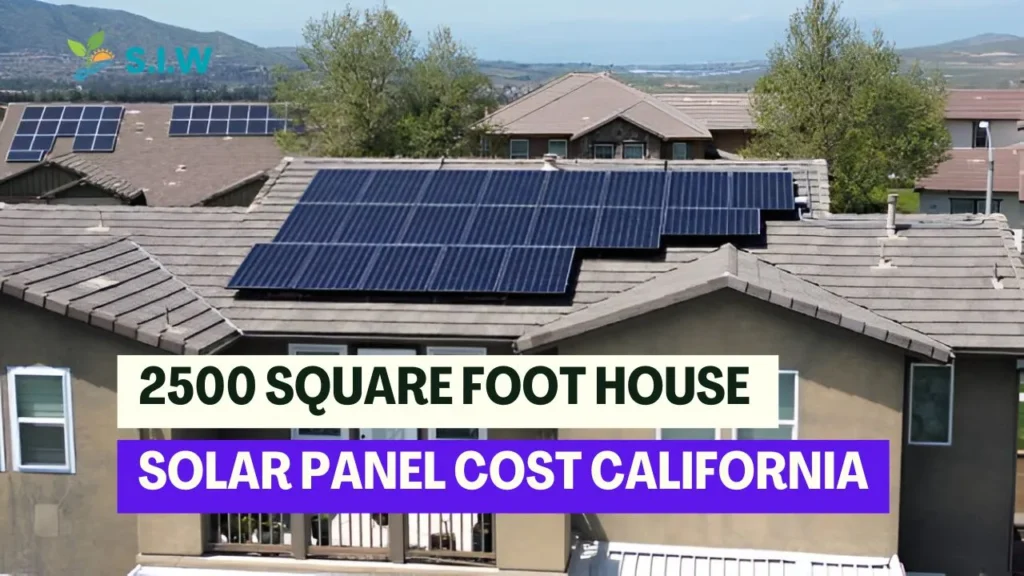As the demand for renewable energy sources continues to rise, many homeowners in California are considering the installation of solar panels. California’s abundant sunshine makes it an ideal location for harnessing solar energy, which can lead to substantial savings on electricity bills and a reduced carbon footprint. However, the cost of installing solar panels can vary based on several factors. This article provides a detailed analysis of the costs involved in installing solar panels on a 2500 square foot house in California, including factors that influence pricing, potential savings, and available incentives.
Factors Influencing Solar Panel Costs
1. System Size and Energy Needs
The size of the solar panel system required depends on the home’s energy consumption and available roof space. On average, a 2500 square foot house in California might require a solar panel system ranging from 6 kW to 10 kW. The exact size needed will depend on the home’s electricity usage, which can be determined by reviewing past utility bills and conducting an energy audit.
2. Solar Panel Quality and Technology
The cost of solar panels can vary based on the type and quality of the panels. High-efficiency panels, such as monocrystalline panels, tend to be more expensive but offer better performance and longevity compared to polycrystalline or thin-film panels. Investing in higher-quality panels can result in better energy production and longer-term savings.
3. Installation Costs
Installation costs can vary based on the complexity of the installation, the type of roof, and the local labor market. Factors such as roof pitch, access, and the need for structural reinforcements can impact installation costs. When choosing among the best solar companies in California, it’s important to consider these variables, as well as the cost of permits and inspections, which can add to the overall expense.
4. Location and Incentives
California’s solar market is highly competitive, which can help lower costs. However, prices can still vary depending on the region and local utility rates. California offers several incentives and rebates that can reduce the upfront cost of solar panels. These include the federal solar investment tax credit (ITC), state-specific rebates, and net metering policies.
Estimated Costs for a 2500 Square Foot House
1. Average Installation Costs
As of 2024, the average cost of solar panel installation in California ranges between $2.50 and $3.50 per watt before incentives. For a 6 kW to 10 kW system, the total cost would be approximately $15,000 to $35,000. This estimate includes both the cost of the solar panels and the installation.
2. Federal Solar Investment Tax Credit (ITC)
The federal ITC allows homeowners to claim a tax credit equal to 30% of the total system cost. For a solar panel system costing $25,000, this would result in a tax credit of $7,500. This incentive can significantly reduce the upfront cost of installing solar panels.
3. State Incentives and Rebates
California offers additional incentives, such as the California Solar Initiative (CSI) and the Single-Family Affordable Solar Homes (SASH) program. While the CSI program has been phased out, new programs and incentives may become available. Homeowners should check with local utility providers and state agencies for current incentives.
Long-Term Savings and Return on Investment
1. Energy Savings
One of the primary benefits of installing solar panels is the reduction in electricity bills. In California, where electricity rates are relatively high, homeowners can see substantial savings over time. On average, a solar panel system can reduce electricity bills by 50% to 80%. The exact savings will depend on the system size, energy consumption, and local utility rates.
2. Return on Investment (ROI)
The return on investment for solar panels is calculated by comparing the total cost of the system to the savings on electricity bills over time. On average, homeowners can expect a payback period of 5 to 7 years, after which the system will continue to generate savings. The ROI can be further enhanced by increasing property value, as homes with solar panels are often more attractive to buyers.
Financing Options
1. Solar Loans
Solar loans allow homeowners to finance the cost of their solar panel system with fixed monthly payments. This option can be beneficial for those who want to install solar panels without paying the full upfront cost. Solar loans often come with competitive interest rates and flexible terms.
2. Power Purchase Agreements (PPAs)
A power purchase agreement (PPA) allows homeowners to install solar panels with little to no upfront cost. Instead, they agree to purchase the electricity generated by the system at a predetermined rate. This can result in lower monthly payments compared to traditional utility bills.
3. Leases
Solar leases are similar to PPAs, but instead of purchasing electricity, homeowners pay a monthly fee to lease the solar panel system. This option can provide immediate savings on electricity bills and requires minimal upfront investment.
Maintenance and Longevity
1. System Maintenance
Solar panel systems are generally low-maintenance. Regular cleaning and occasional inspections are typically sufficient to keep the system operating efficiently. Most solar panel manufacturers offer warranties ranging from 10 to 25 years, ensuring long-term performance and reliability.
2. System Longevity
Solar panels are designed to last for several decades. Most systems have a lifespan of 25 to 30 years, with performance gradually decreasing over time. Advances in technology and manufacturing processes continue to improve the durability and efficiency of solar panels.
Conclusion
Installing solar panels on a 2500 square foot house in California can be a significant investment, but it offers considerable long-term benefits. Understanding the factors that influence the cost, exploring financing options, and taking advantage of available incentives can help make solar energy a viable and cost-effective solution for homeowners.
By investing in solar panels, homeowners not only contribute to a more sustainable future but also enjoy the financial benefits of reduced electricity bills and increased property value. As technology advances and costs continue to decrease, solar energy is becoming an increasingly attractive option for those looking to harness the power of the sun.








